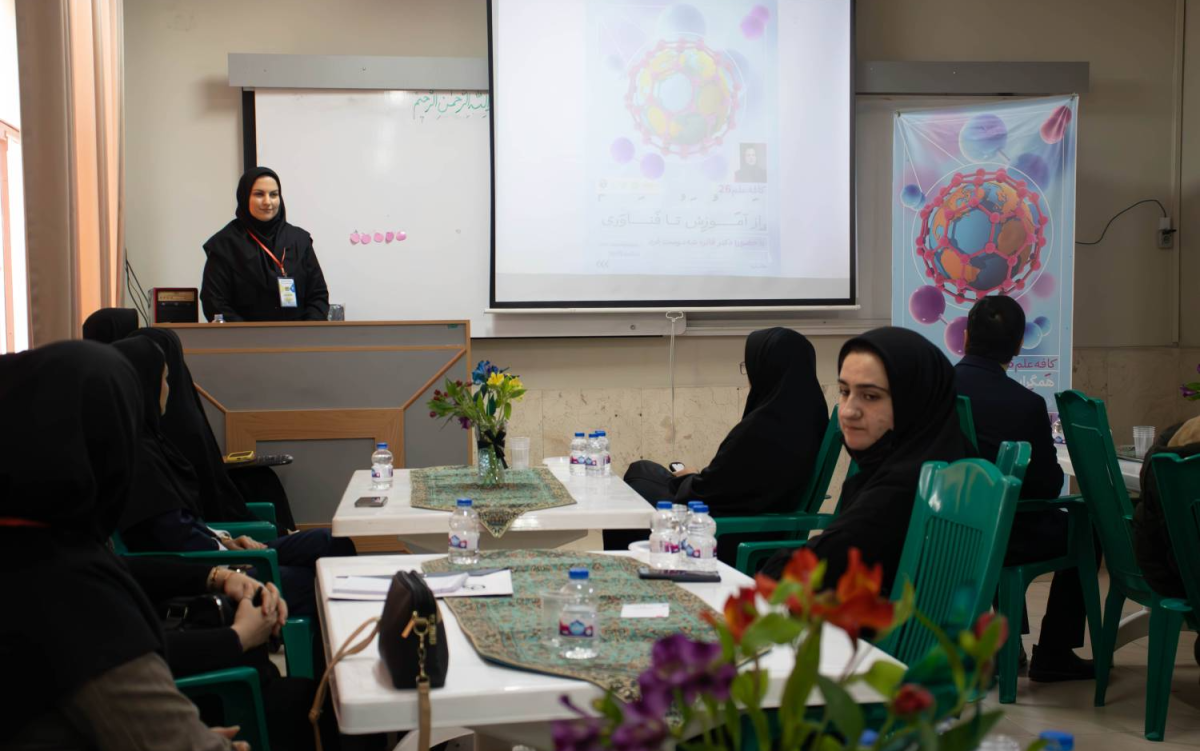Technologies Converge to Tackle a Complicated Disease


Technological convergence holds promise for new therapeutic approaches for diseases such as cancer. The 26th Mustafa(pbuh) Prize Science Café, which was the first Science Café held in Isfahan, focused on using these technologies for cancer treatment.
MSTF media reports:
The 26th Science Café, focusing on the convergence of experimental sciences with an emphasis on nanotechnology, was held on the sidelines of the 4th National Conference on Experimental Science Education (PCK). This event featured student-teachers and educators in a friendly atmosphere at Farhangian University of Isfahan. Faezeh Shahdost-Fard, a faculty member in the Department of Chemistry at the University of Isfahan, elaborated on the role and significance of the Mustafa(pbuh) Science and Technology Foundation in organizing Science Cafés and explained the concept of technological convergence.
Shahdost-Fard referred to the history of technological convergence since 2002 and the influence of reports from the U.S. National Science Foundation in this field, emphasizing the importance of developing a shared language among different sciences. She explained that technological convergence represents an interdisciplinary and transdisciplinary approach, integrating various scientific fields.
The professor stated: “When knowledge reaches saturation point, its rate of innovation slows down. That is when sciences need to come together, merging across disciplines to contribute to human well-being. The integration of sciences enhances food security, social relations, healthcare quality, and more.”
Information Technology, Nanotechnology, Biotechnology, and Cognitive Science together form what is known as NBIC (Nanotechnology, Biotechnology, Information Technology, and Cognitive Science). This interdisciplinary technology aims to bring about a major leap forward in human life.
One application of technological convergence is in developing new therapeutic methods for diseases such as cancer. In 2023, 609,820 people worldwide lost their lives to cancer. Seven thousand people per hour and approximately two people per second die from this disease. The most commonly reported cancers in 2020 were breast, lung, colorectal, prostate, skin, and stomach cancers.
Various factors can contribute to cancer development. Overall, aging, lifestyle choices, alcohol consumption, and obesity are among the key contributors.
Shahdost-Fard highlighted the limitations of traditional cancer treatments, which affect not only cancer cells but also healthy cells. She emphasized the importance of targeted drug delivery for cancerous cells. She explained, “Old cancer treatments, that use different drugs or radiation, impact all body cells. By destroying healthy cells, they pose a risk to overall health. This is why we often hear that a person has passed away because of complications caused by the disease.”
Nanotechnology has been introduced as a method for targeted drug delivery in recent years. Nanotechnology deals with materials and particles at an extremely small scale. To understand how small these materials are, imagine the measurements of the human body in meters. A hand is about 10 centimetres long, and the diameter of a human hair would be measured in micrometers. Nanomaterials would be a billionth of that, or 10⁻⁹ (10 to the power of -9) meters.
In the nanoscale world, where materials cannot be seen without special tools, remarkable properties emerge. For example, everyone has seen the color of gold, but interestingly, at the nanoscale and with different morphologies, gold can have various colors such as red.
The professor cited the research of Omid Farokhzad, a recipient of the 2023 Mustafa(pbuh) Prize, as an example of the high potential of targeted drug delivery for treating cancer patients.
Quoting Farokhzad, Shahdost-Fard said: “When I worked on nanomaterials and published valuable papers on them, I always wondered whether these studies were actually improving people’s quality of life.”
Farokhzad pursued his postdoctoral studies at Harvard University, where he met Robert Langer. When Langer heard Farokhzad’s ideas, he told him that while his concepts were suitable for research papers, if he truly wanted his technologies to impact people’s lives, they needed to reach clinical trials and practical applications. This is where the idea of targeted nanodrug delivery was born.
With a degree in business management, Farokhzad sought to translate research into practice. He recalled, “While working on research articles, I would occasionally step back to see whether I am heading in the right direction. I would ask myself whether the knowledge I’m producing has a positive impact on people’s lives.”
Later, Farokhzad founded a company specializing in the production of nanodrug carriers. He wanted to commercialize his innovations, and the breakthrough came when a woman with uterine cancer, who had been failed by all treatment options, was successfully treated using his targeted nanodrug carriers.
Later, this patient was interviewed by various news outlets spontaneously without prior planning, crediting the new nanomedicine for saving her life. As a result, Farokhzad’s company entered the stock market, bringing him significant financial success.
Farokhzad is just one example of scientists who have leveraged interdisciplinary sciences to develop innovative medical solutions. There is still a strong need to expand the use of technological convergence to make science more applicable. We need systems that can continuously monitor human health metrics, on a daily or even a second-by-second basis. Nanochips, an emerging nanotechnology tool, assist doctors in early diagnosis and even provide them with hourly and daily reports.
In this new era, vast amounts of data are generated, which can be stored as big data by Information Technology. This technology is crucial for researchers like Omid Farokhzad, who need to evaluate the effectiveness and side effects of clinical trials involving large numbers of patients.
Shahdost-Fard concluded by emphasizing the importance of interdisciplinary technology in education. She stressed that by incorporating interdisciplinary approaches, students, researchers, and future scientists can develop more practical and impactful knowledge, ultimately improving the quality of human life.
Science Café is a promotional program that provides a friendly and discussion-based platform for exploring scientific advancements. These gatherings feature scientists or science communicators who present scientific topics in an accessible manner for the audience. Science Cafés offer students and science enthusiasts a great opportunity to ask questions and engage in discussions with experts.